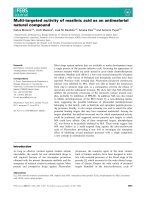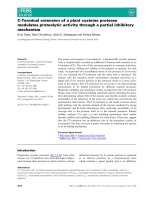Tài liệu Báo cáo khoa học: "Some New Terminology" pptx
Bạn đang xem bản rút gọn của tài liệu. Xem và tải ngay bản đầy đủ của tài liệu tại đây (123.26 KB, 2 trang )
[
Mechanical Translation
, vol.4, no.3, December 1957; pp. 52-53]
Some New Terminology
Erwin Reifler, University of Washington, Seattle, Washington
MT research requires cooperation between engineers and linguists. It is impor-
tant, therefore, to develop a uniform linguistic terminology that can be understood
and used by engineers. Furthermore, it is necessary that linguists develop an un-
derstanding of the engineering problems involved. The results of cooperation be-
tween linguists and engineers working with the MT Pilot Model at the University of
Washington are presented here.
THE LINGUIST interested in pioneering in MT
has to struggle with two difficult problems
from the very outset: 1) the formulation of an
adequate linguistic terminology that can be un-
derstood and used by the engineer, and 2) an
understanding of the engineering problems in-
volved. During our eight years of MT re-
search at the University of Washington we have
had the great advantage of close cooperation
between linguists and engineers. I wish to sub-
mit for discussion under the heading of "Ter-
minology" some of the results of this coopera-
tion.
Recent developments in MT research at the
University of Washington have necessitated the
redefinition of some old linguistic terms and
the formulation of some new ones. They con-
cern the concepts of MT symbols, i.e., all
graphic symbols used in the machine translation
process. These MT symbols consist of the
Control Symbols and Contextual Symbols.
1.
Control Symbols — MT symbols which,
coded into the machine memory, control cer-
tain steps in the translation process. Since
they are not contextual symbols, they appear
neither in the input nor in the output.
2.
Contextual Symbols — the minimal contex-
tual constituents used to produce a material
stimulus for a machine-operational step rele-
vant for MT, such as an alphabetic letter, a
numerical figure, a dollar sign, a punctuation
mark, a single space. Contextual symbols
consist of Input Symbols and Output Symbols.
3.
Input Symbols include all contextual sym-
bols that may appear in a source text.
4.
Output Symbols include:
a)
Letter symbols of the target alphabet
b)
Symbols for the numerals
c)
Punctuation symbols
d)
Editing symbols — target symbols in-
tended to aid in the interpretation of the MT
product. Examples are subscript numbers
which are attached to some target equivalents
to pinpoint the field or fields of science to which
the scientific meanings of certain semantic units
of the source language belong. (The term "se-
mantic unit" will be explained below.)
5.
Free Symbol — a contextual symbol pre-
ceded and followed by space. It is always
meaningful and always used to symbolize both
grammatical and non-grammatical meaning.
An example is English 'I'.
6.
Bound Symbol — a contextual symbol either
not preceded or not followed, or neither pre-
ceded nor followed by space. We distinguish
a)
Left-bound symbols
b)
Right-bound symbols
c)
Twice-bound symbols
7.
Meaningful Bound Symbol — a contextual
symbol used to symbolize:
a) Grammatical meaning, i.e., left-bound
"s" in "father's, fathers", the right-bound " ' "
in " 's" which indicates that the following "s" is
a substantive ending, the twice-bound "o" in
"arterio-sclerosis."
New Terminology 53
b)
Non-grammatical meaning, i.e , the
left-bound "g" which distinguishes the meaning
of "pang" from that of "pan", the right-bound
"s" which distinguishes the meaning of "span"
from that of "pan", the twice-bound "a" distin-
guishing the meaning of "seat" from that of
"set."
c)
Both grammatical and non-grammatical
meaning, i .e . , right-bound "о" distinguishing
the grammatical and non-grammatical meaning
of описать 'describe’ (perfective aspect) from
that of писать 'write' (imperfective aspect),
left-bound “я”
distinguishing the grammatical
and non-grammatical meaning of ломя
'break-
ing' from that of лом
'crowbar', twice-bound
"ж" distinguishing the grammatical and non-
grammatical meaning of между
'between' from
that of меду ' of the honey'.
8. Meaningless Bound Symbol — a bound
symbol not intended by the author of a source
text to symbolize anything, but treated as a
separate entry by the MT planners in order to
overcome engineering difficulties due to certain
limitations of the MT equipment. An English
example is the arbitrary left-bound final sym-
bol "n" in "misinterpretation" which consists
of 17 letters. If, for example, the input equip-
ment cannot handle free symbol sequences
longer than 16 letters, then "misinterpretation"
may be split arbitarily into two constituents,
the first of which contains the first 16 letters
while the second consists of only one letter.
These two constituents would then form two
separate entries in the machine memory.
9). Symbol Sequence — a sequence of contex-
tual symbols not interrupted by space.
10.
Free Symbol Sequence — a symbol se-
quence preceded and followed by space. A free
symbol sequence is always meaningful and is
always used to symbolize both grammatical
and non-grammatical meaning.
11.
Bound Symbol Sequence — a symbol se-
quence either not preceded, or not followed, or
neither preceded nor followed, by space. We
distinguish:
a)
Left-bound symbol sequence
b)
Right-bound symbol sequence
c)
Twice-bound symbol sequence
12.
Meaningful Bound Symbol Sequence — a
bound symbol sequence used to symbolize:
a)
Grammatical meaning, i.e., left-bound
"ren" in "children", and right-bound "be" in
"befall" which changes the intransitive meaning
of "to fall" into a transitive meaning, twice-
bound ыв
distinguishing the grammatical mean-
ing of описывать 'to describe' (imperfective
aspect) from that of описать 'to describe’ (per-
fective aspect).
b)
Non-grammatical meaning, i.e., left-
bound "et" distinguishing the meaning of "ballet"
from that of "ball", right-bound "bl" distinguish
ing the meaning of "bleat" from that of "eat",
twice-bound "ur" distinguishing the meaning of
"gourd" from that of "god".
c)
Both grammatical and non-grammatical
meaning, i.e., left-bound "shore" in "sea-
shore", right-bound "sea" in "seashore", and
twice-bound "en" in "disentomb".
13.
Meaningless Bound Symbol Sequence — a
bound sequence not intended by the author of a
source text to symbolize anything, but treated
as an individual entry by the MT planners in
order to overcome engineering difficulties due
to certain limitations of the MT equipment. An
English example is the meaningless left-bound
symbol sequence "ss" in "irreconcilableness"
which consists of 18 letters. The MT planners
would have to split this free symbol sequence
into two arbitrary constituents containing 16
and 2 letters respectively, and enter them as
separate entries into the machine memory if
the available input equipment cannot handle
free symbol sequences longer than 16 letters.
14.
Group of Free Symbol Sequences — a
complete text or any part of a text, chapter,
section, sentence or clause consisting of two
or more free symbol sequences which symbol-
ize a meaning intended by the author of the
source text.
15.
A Semantic Unit — a single free or bound
meaningful symbol or symbol sequence, and
any group of free symbol sequences which is
idiomatic in terms of source-target semantics.
With the growth of MT development and the
increase in the number of MT pioneers it is
becoming more and more important to achieve
some uniformity in linguistic terminology for
MT. I submit the above definitions for criti-
cism and suggestions.









